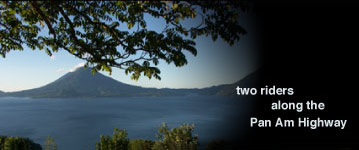
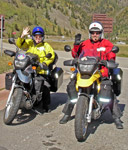
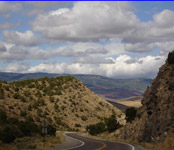
view corresponding gallery | previous entry | next entry
entry 20: ecuador 05/04/06
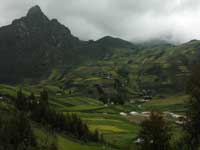 |
| One of the many gorgeous vistas in Ecuador. The crops make a quilt on the hillsides. |
Stroll South America! After a three hour layover in Bogotá, Colombia - still dressed in shorts and t-shirts, we found ourselves on South American soil about 16 miles south of the equator. At 9,252 feet above sea level and with light rain falling, it was a cool (50 degree) Quito evening. I admit the curious child in me made me flush the toilet four times just to watch the water swirl counter-clockwise down the drain. Cool.
We started out our first morning fairly anxious to get our bikes back, so we called the Girag Cargo office in Quito. They told us our bikes had arrived and to come to their office. We gave the cab driver the address and after several minutes figured he had gotten us lost because not only were we not close to the airport but we were in a residential area. Our driver had to ask three times for directions and finally he pulled up in front of a non-descript gray building in the middle of a neighborhood. He pushed the intercom button, the door swung open, and we went up an outside walkway to a second floor office where we finally saw a Girag sign above their door. We paid $22 per bike to get the shipping receipts and then asked to see our bikes. “Oh no, your bikes are not here. You need to go to the customs office at the airport.” Well now that made sense! We jumped back into the cab (how smart we were to have asked him to wait!) and he took us to the airport where, after 30 minutes of asking for the customs office, we found the correct window in the correct building. Noticing that this window would close for lunch soon, we hoped this wouldn’t take long – hopes which turned out to be a bit naive. A stone faced lady took our passports and paperwork, had a discussion with another lady in the office and then explained that I could possibly get my bike out of customs in three days but Lynne could not. The problem was that the lady at Girag in Panama had made a typo on Lynne’s last name (one too many “e”s) and although Lynne had spotted it right away in Panama, the correction had been made only on the top copy (with white-out) and we were now dealing with carbon copies that still had the mistake on them. To correct this, Ecuadorian customs would require a letter from Girag saying that a correction had been made and we would have to wait until Monday and then maybe we would get our bikes out of customs.
Once again a kind English-speaking local came to our rescue. She was also dealing with belongings held up in customs and so she took us under her wing and explained the only practical way of getting things done quickly here was to hire a customs expeditor. In other words you need to pay a middleman to grease the palms of the customs agents. We then remembered other riders telling us of hiring these expeditors, so we went off in search of Bertha - who was said to have had some experience with motorcycle imports.
We found her office down the street, but of course there was no one in it. The lady next door offered a place to sit while we waited – which we did for 30 minutes, after which Bertha and what appeared to be 5 other family members trickled in. Great! For $50 per bike we had an expeditor and things were looking up. But in reality, things really went downhill from there. We actually broke down and giggled like school children after a series of events we watched while waiting in the office. First, the typewriter they attempted to type our documents on did not work, so they borrowed another sorry-looking one from the office next door. This typewriter was in constant “caps lock” and did not have a #1 key, so none of the important number sequences could be typed. While all this was going on, we asked to borrow a pen to take some notes with, and after a few minute search, they did come up with one pen. After four words, the pen ran out of ink. Obviously they don’t spend a lot on office products. Things continued like this for about 6 hours while Bertha and her helpers typed documents, had them copied many times at a copy store down the street (at our expense), and scurried to about six other offices to persuade various officials to accept our paperwork. It turned out that the typo on Lynne’s paperwork, along with the omission of the color of her bike on the paperwork were causing some real problems. (How many BMW 650’s did they have in that cargo bay anyway?) Finally, at 5:15pm, after $144, six hours and two rolls of Tums we rode the bikes out of customs and into our hotel parking garage in Quito. It was great to be reunited with the whales and they appeared to have made the trip none worse for the wear.
From our hotel in central Quito, we could hear the crowds roar in the soccer stadium across the street. I could see some of the bleachers and those dressed in red and blue seem to be cheering the most. Team colors are big in soccer - the team name itself does not appear on the uniforms; instead all of the patches on the jerseys are company logos. I’m a bit surprised professional sports in the U.S. haven’t gone that route (other than Nike). I found out later that the Quito team will be part of the national team that plays in the World Cup in June. We hope to see a soccer match before our trip ends - everyone here talks so much about them.
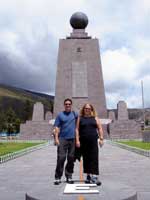 |
Standing right on the equator at Mitad del Mundo |
Finding ourselves in need of some fun, we ventured up to Mitad del Mundo, the exact spot of the Middle of the World. This park is about 15 miles north of Quito and celebrates the equator with a scenic viewing point housed in a tower, a museum of indigenous Ecuadorians, a planetarium, and the usual shops and restaurants. It was here that we got to sample some fanesca – a local delicacy consisting mostly of beans which is prepared only during Holy Week. We thought it was delicious. Even more fun was the Inti Nan museum right down the road which spotlights local customs and has an interactive area where you can balance a raw egg on the head of a nail and pour water down drains placed north, south and directly on the equator to demonstrate the clockwise, counter-clockwise and straight down motion of water. It was here that we learned that guinea pig is a staple in the Ecuadorian diet. This explains the many road signs offering “cuyes” for sale that we have seen. Lynne thought they were being sold as pets.
We also took the time to take the bikes into the BMW shop to have our chains and sprockets replaced. The original ones still looked good, but with almost 13,000 miles on the chains - plus the fact that I’ve been carrying the heavy spares from the start of the trip, made the decision to change them pretty easy. Labor costs were $49 for both bikes and they cleaned the brakes and bikes as well.
The following week consisted of booking some local tours and finding a boat for our trip out to the Galapagos Islands. The tour company we used is called Safari and it was recommended by the Footprints guide book, and also by our friends Norm and Maggie who used them on their way through Ecuador. We also highly recommend them – they were able to come up with a great last-minute deal on an 8 day cruise to the Galapagos for us. There is so much to say about the islands, we’ve made a separate page.
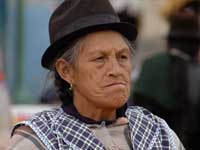 |
| A vendor ar the street market reflecting on a deal she just made with Lynne. |
Our first day trip was to the market in Zumbahua, a town about three hours south of Quito. The market was not as good as we had expected, although it was interesting in another way - with locals gathering around pots of stewed goat and lamb. We stepped over more than one jawbone that had been discarded by a patron of a food stall. The highlight of the trip was the actual drive through the Andes Mountains. Small fields of corn, beans and some grains I could not identify turned into large quilts of green and brown squares when viewed from the valley. And when you reached the summit and looked down at flashes of light gray and blue, you saw what appeared to be small lakes, but were actually acres of green houses (really huge tents) used for growing roses. Ecuador is one of the top producers in the world for roses and a dozen long stems will run you $2.50 on a street corner. At midday, our guide, Fernando, took us to the hacienda of a good friend in the mountains. They not only graciously welcomed us, but let us eat lunch in their kitchen and supplied us with fresh cheese and a juice drink that is made from a fruit that looks like a pear tomato but grows on a short tree. It was pretty tasty - but a little thick.
Our second day trip was to Otavalo and its Indian Market, located about two and a half hours to the north of Quito. We had the same guide, Fernando, and he took Lynne and me to the best leather works and wood craft shops in along the way, as well as to the market. It was impressive to see leather cut and sewn into hats and hand bags with machines that have obviously been in use for several generations. Again, the country side was impressive - this time with a stop at the National Park to have lunch beside Lago Cuicoche, a deep lake formed by a sunken volcano. We again spotted many cui (guinea pig) signs along the road, which are served in a variety of ways, the most common being roasted.
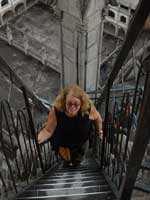 |
| Climbing the tower stairs at the Basilica |
We also bummed around central Quito for a few days while waiting for our trip to the Galapagos and spent one day going to churches and museums. The first church that caught our attention were the La Compania, a Jesuit church where almost everything is covered in gold - truly impressive, but unfortunately no pictures were allowed to be taken inside the church. The second church we visited was a gargantuan spectacle - the Basilica. Covered with gargoyles and stained glass, it has been under construction for over 100 years and is not yet finished. Here we climbed up into steeples using ladders that definitely were not OSHA approved - but provided some great views of Quito.
After spending an almost indescribable week in the Galapagos (see seperate page), we headed south along the PanAm once again. All things considered it felt pretty good to be back on the bikes but it took our rear-ends a few days to get back into riding mode. Leaving Quito, we rode for five hours to reach Riobamba, a town not really that far from Quito as the crow flies. The climb in and around the mountains of Ecuador was really pretty, but tough to make time on. This slow meander became a pattern of the days to come as gray skies gave way to fog to mist to rain and the temperature at 12,000 feet was a steady 50 degrees. Our hotel in Loja a few nights later had no heat - but enough blankets on the bed to crush a six-pack. The Pan-American Highway was at times smooth asphalt, then strewn with pot-holes, then turning to gravel or mud. Usually a land slide was the cause for the lack of asphalt and parts of the hill were still sitting on the road - making for one-lane traffic at times. Lynne had strained eyes at the end of the day after contending with fog, rain, rocks, cattle, dogs, mules and goats on the road. We averaged about 30 miles an hour and we had to ride 7 hour days in order to move about 100 miles south on the map.
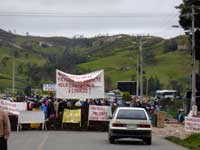 |
| People, mounds of dirt, barricades, fires and large rocks all blocking the PanAm |
Our last day in Ecuador showed us democracy in progress. We were stopped shortly after leaving Loja by a long string of parked vehicles, mostly trucks. As we had learned from past experience, it pays to ride up to the front of the line to see what’s going on. A police barricade had been set up in front of a large group of locals who were protesting about water rights. They had blocked all traffic on the Pan-American Highway and would be doing so for the next 24 hours. We were handed a pamphlet by one of the demonstrators, and after a quick deciphering, came to understand the protest was about the negative effects that gold mining was having on their water sources. We asked an officer if we could ride through and he said it would be OK - our motorcycles would fit through the barricades. The country folk (especially the women), however, would have none of it. For the first time on the trip our smiles got us nowhere, and Lynne was quickly surrounded by yelling locals. Thankfully, some of the people standing to the side quietly hinted that we could cut down a dirt road that wound through a village on the hillside in order to get around the roadblock. We took their advice and ended up a mile down the road where we were stopped once again. This time it was a chain across the end of the dirt road and concrete forms with a 14-inch clearance leading onto a new section of highway that were in our way. Well, the four workers (who were not working) decided that a $2 fee would eliminate both obstacles and soon we were back on the road. It didn't take long to notice that the road we were headed down had no other vehicles on it - and we knew that wasn’t a good sign. Sure enough there was another road block ahead, complete with burning piles of trash, boards with nails sticking up and barbed wire strung down to the ditches. We did not stop this time (tired of smiling) and Lynne rode through the burning pile and I followed. No one screamed or chased us and we thought we were home-free - but a quarter mile down the road we were stopped once again by barbed wire strung across the road at handlebar height. Luckily, this road block was poorly manned, with only three or four guys sitting off to the side. Lynne stopped in front of the wire, I jumped off my bike, picked up the wire and Lynne drove forward. She lifted it for me and we got the hell out of there. Our ride through their demonstration in no way signifies our indifference to their struggle, only our for-the-moment ignorance of it.
Ecuador was a great experience but it is now time for Peru!
On a different note, I would like to apologize to anyone who has been reading our travel journal and has noticed the lengthening time between entries. Either the Stroll has made me very lazy or we are having way too much fun. Either way - more entries with less elapsed time in-between are our new goal.

Copyright © 2005 All content and photography are the property of Tom and Lynne Gefre.
Contact us if interested in publishing or reusing any material.